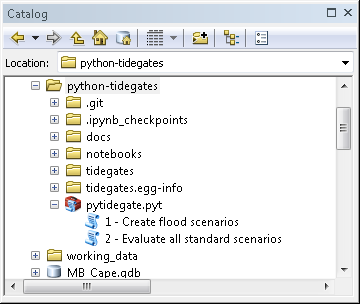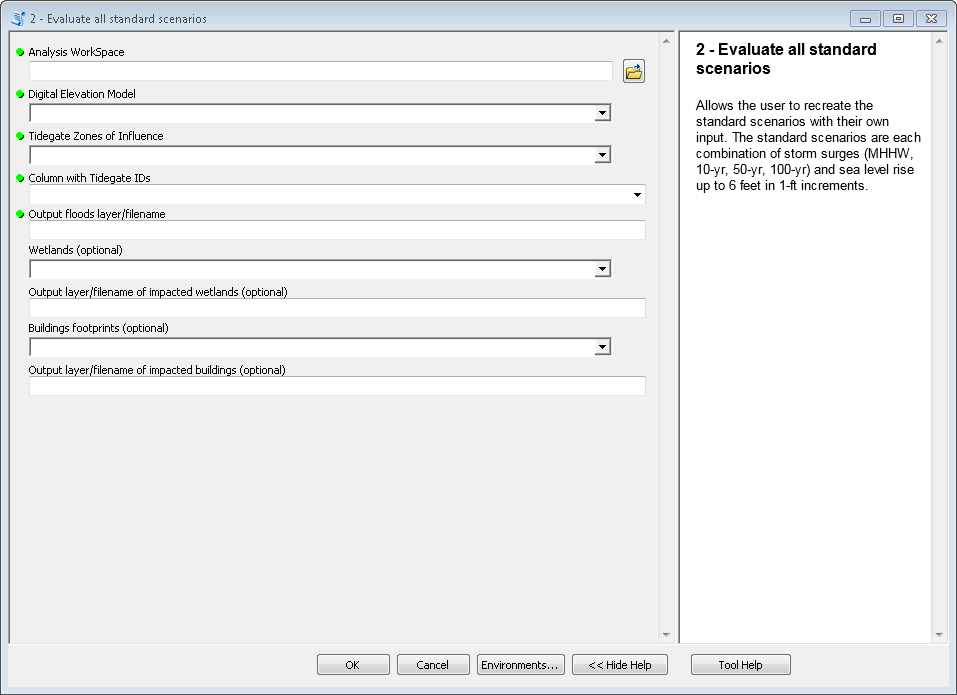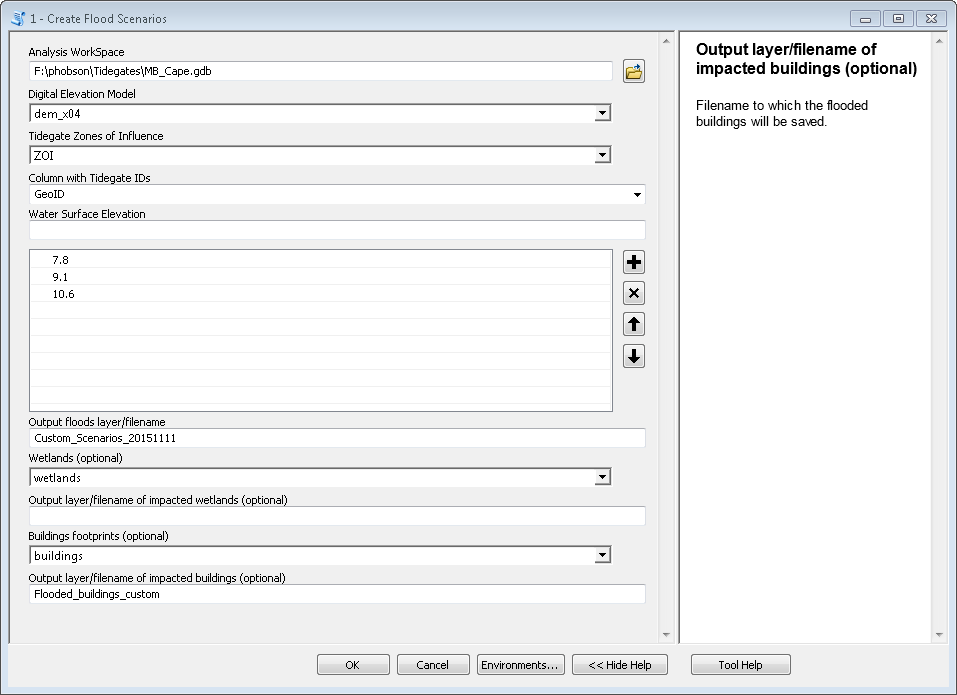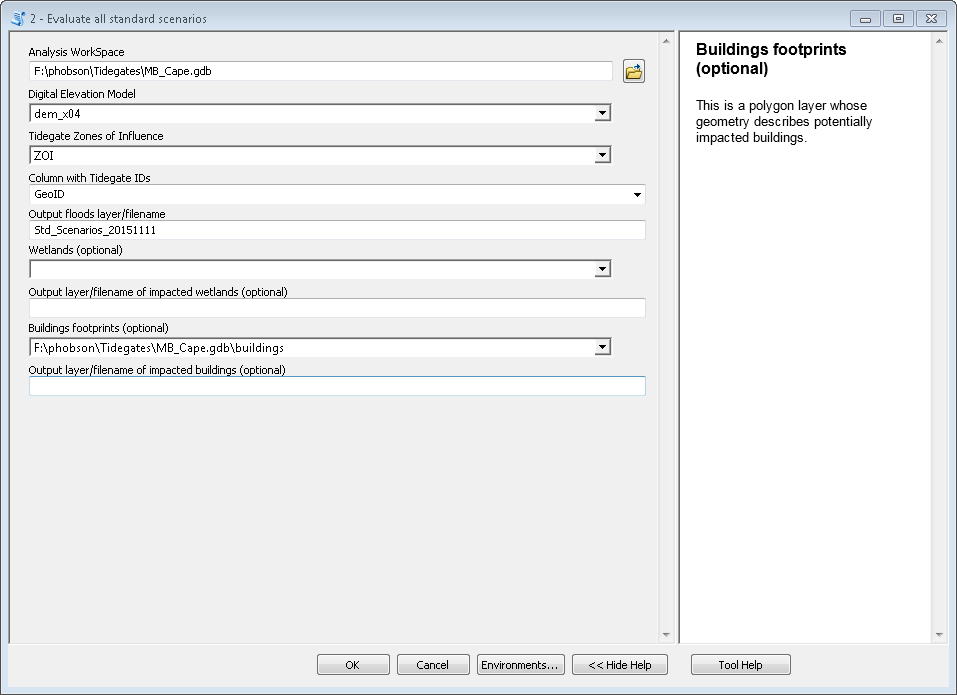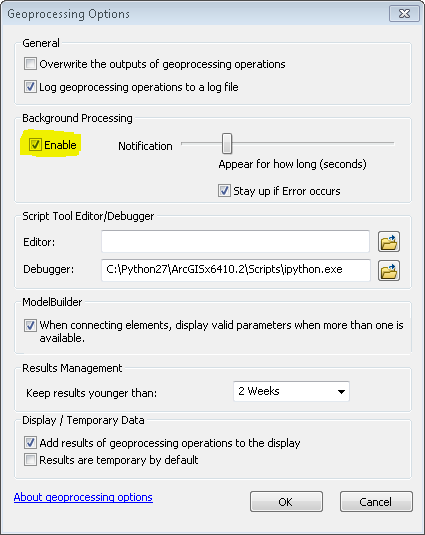Using python-tidegates as a python-toolbox in ArcGIS¶
Finding the toolbox¶
After you download or clone the source code (see install instructions), you can navigate to the source directory in ArcCatalog:
At this point you can double click either of the tools to use them.
Inputs to the toolboxes¶
Both toolboxes take identical parameters with one exeception: the toolbox titled 1 - Create flood scenarios allows the user to input multiple elevations to be analyzed. In contrast, the form titled 2 - Evaluate all standard scenarios automatically evaluates all of the elevations associated with the so-called “standard scenarios”. These include all of the combinations of sea level rise in 1-ft increments from 0 to 6 ft MSL, and storm surges events including:
- Mean higher high water
- 10-yr storm surge
- 50-yr storm surge
- 100-yr storm surge.
Common input parameters¶
The following are the parameters shared by both toolboxes. All parameters are required except where noted.
- Analysis Workspace (
workspace) This is the folder or geodatabase that contains all of the input for the analysis.
Note
All of the input for the analysis (see below) must be in this workspace.
- Digital Elevation Model (
dem) This is the raster dataset that contains the gridded topographic and bathymetric data that will be used to determine the extent of flooding. The original geodatabases provided contain DEMs: one at 4-m, and a second at 8-m resolution. The finer resolution DEM provides more detailed output, however it also requires more runtime and the analysis requires more computational resources. If the tool runs into a
MemoryErrorduring an analysis, try using the lower resolution raster. If these errors persist, Other things to try include limiting the number ofzonesanalyzed or reducing the resolution of the raster even further.Note
The elevations of the DEMs provided in the standard geodatabase are measured in meters. However, care is taken to convert the properly convert the user input into meters to match the DEM when determining the extent of flooding.
- Tidegate Zone of Influence (
zones) - This is a polygon layer found in workspace that delineates the zone of influence of each tidegate. The original geodatabases provided include a dataset called “ZOI” that include this information.
- Column with Tidegate IDs (
ID_column) - This is the name of the field in the
zonesparameter that contains the unique idenifier of each tidegate. When using the “ZOI” layers provided in the geodatabases, this should be set to “GeoID”. - Output floods layer/filename (
flood_output) This is the filename to which the extent of flooding will be saved within
workspace.Warning
Both toolboxes will overwrite any previous output if duplicate filenames are provided.
- Wetlands, optional (
wetlands) - This is a polygon layer found within
workspacethat delineates wetlands within a study area. If provided, the area of wetlands inundated during each flood scenario will be added to theflood_outputlayer. - Output layer/filename of impacted wetlands, optional (
wetlands_output) - This is the filename of the layer created by computing the intersections of
flood_outputandwetlands. The result is a shapefile/feature class that contains only the inundated areas of the wetlands. Ifwetlands_outputis not provided, the information is not saved to disk. - Building footprints, optional (
buildings) - This is a polygon layer of the building footprints in the study area.
If provided the number of impacted buildings will be added to each record of
flood_output. - Output layer/filename of impacted buildings, optional (
building_output) This is the filename of an output layer that contains all of the impacted buildings for each flood scenario. If
building_outputis not provided, the information is not saved to disk.Warning
Both toolboxes will overwrite any previous output if duplicate filenames are provided.
Custom elevations¶
The toolbox titled 1 - Create flood scenarios allows the user to input multiple elevations to be analyzed. Thus, it has an elevation user-input parameters that is not used by 2 - Evaluate all standard scenarios. In keeping with the formatted definitions below:
- Water Surface Elevation (
elevation) - A series of multiple custom flood elevations (in feet MSL) to be analyzed.
Examples of filled out forms¶
If you encounter a MemoryError¶
By default, ArcGIS geoprocessing operations occur in the “foreground”. What this means is that the geoprocessing occurs within ArcMap or ArcCatalog, rather than in a separate computation process. The major implication of this are is those geoprocessing operations are limited to ArcGIS’s 32-bit version of python. Any 32-bit process is only able to access roughly 3 gigabytes of RAM (this various with other hardware in the machine).
In constrast, 64-bit applications have a theoretical maximum RAM limit of server million terabytes. In other words, about as much RAM as you have on a modern personal computer that happily runs ArcGIS. Recognizing this, Esri also provides a 64-bit python that can operate in the “background” (i.e., a separate process from ArcGIS).
This can be enabled from the Geoprocessing | Geoprocessing options menu in ArcGIS. Doing so may solve issues where the toolboxes fail due to an MemoryError (running out of RAM). However, some datasets are Just-Too-Big for ArcGIS or your computer and will continue to raise errors. In these cases, it’s best to split up the datasets – especially – the rasters into multiple layers.
Other ways of using python-tidegates¶
Since python-tidegates is a python-based toolbox for ArcGIS, great care was taken to create the tool such that it could be called from python without opening ArcMap or ArcCatalog. Using the tools from a python intepreter is described in the next section.
